

Howard Gardner, multiple intelligences and education. Howard Gardner, multiple intelligences and education.
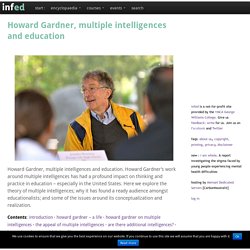
Howard Gardner’s work around multiple intelligences has had a profound impact on thinking and practice in education – especially in the United States. Here we explore the theory of multiple intelligences; why it has found a ready audience amongst educationalists; and some of the issues around its conceptualization and realization. Contents: introduction · howard gardner – a life · howard gardner on multiple intelligences · the appeal of multiple intelligences · are there additional intelligences?
· howard gardner’s multiple intelligences – some issues and problems · conclusion · further reading and references · how to cite this article I want my children to understand the world, but not just because the world is fascinating and the human mind is curious. Howard Earl Gardner’s (1943- ) work has been marked by a desire not to just describe the world but to help to create the conditions to change it. Howard Gardner – a life Mindy L. Technology and Multiple Intelligences. What are the multiple intelligences?
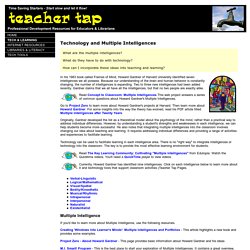
What do they have to do with technology? Multiple Intelligences. Multiple Intelligences The theory of multiple intelligences was developed in 1983 by Dr.
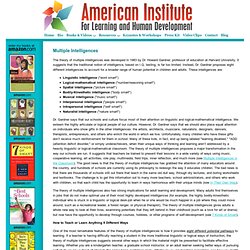
Howard Gardner, professor of education at Harvard University. It suggests that the traditional notion of intelligence, based on I.Q. testing, is far too limited. Instead, Dr. Gardner proposes eight different intelligences to account for a broader range of human potential in children and adults. Linguistic intelligence ("word smart") Logical-mathematical intelligence ("number/reasoning smart") Spatial intelligence ("picture smart") Bodily-Kinesthetic intelligence ("body smart") Musical intelligence ("music smart") Interpersonal intelligence ("people smart") Intrapersonal intelligence ("self smart") Naturalist intelligence ("nature smart") Dr.
Multiple Intelligences Overview. TIP: Theories. The theory of multiple intelligences suggests that there are a number of distinct forms of intelligence that each individual possesses in varying degrees.
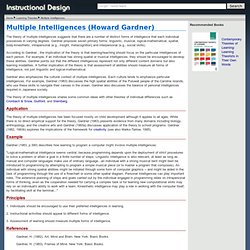
Gardner proposes seven primary forms: linguistic, musical, logical-mathematical, spatial, body-kinesthetic, intrapersonal (e.g., insight, metacognition) and interpersonal (e.g., social skills). According to Gardner , the implication of the theory is that learning/teaching should focus on the particular intelligences of each person.
For example, if an individual has strong spatial or musical intelligences, they should be encouraged to develop these abilities. Gardner points out that the different intelligences represent not only different content domains but also learning modalities. A further implication of the theory is that assessment of abilities should measure all forms of intelligence, not just linguistic and logical-mathematical. Gardner also emphasizes the cultural context of multiple intelligences. Application Example Principles. Howard Gardner School. Howard Gardner Topics Menu. Welcome to the Learning, Design, and Technology Program at Penn State!
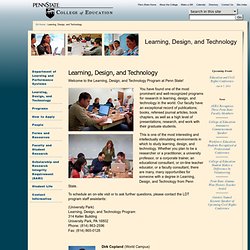
You have found one of the most prominent and well-recognized programs for research in learning, design, and technology in the world. Our faculty have an exceptional record of publications; books, refereed journal articles, book chapters, as well as a high level of presentations, research, and work with their graduate students. This is one of the most interesting and intellectually stimulating environments in which to study learning, design, and technology.
Whether you plan to be a researcher or a practitioner, a university professor, or a corporate trainer, an educational consultant, or on-line teacher educator, or a faculty consultant, there are many, many opportunities for someone with a degree in Learning, Design, and Technology from Penn State. To schedule an on-site visit or to ask further questions, please contact the LDT program staff assistants: Human Intelligence: Howard Gardner. This page is now located at an updated address.
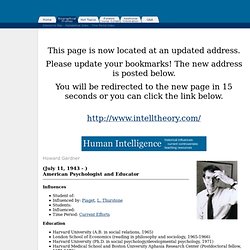
Please update your bookmarks! The new address is posted below. You will be redirected to the new page in 15 seconds or you can click the link below. Howard Gardner. GreatSchools.net. Schools, High School, Public Schools, School District, Public High Schools - SchoolMatters.
Brain-Based Learning. The Brain and Learning. The Organ of Learning To many, the term “brain-based learning” sounds redundant.
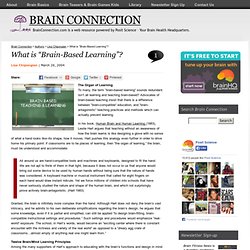
Isn’t all learning and teaching brain-based? Advocates of brain-based teaching insist that there is a difference between “brain-compatible” education, and “brain-antagonistic” teaching practices and methods which can actually prevent learning. In his book, Human Brain and Human Learning (1983), Leslie Hart argues that teaching without an awareness of how the brain learns is like designing a glove with no sense of what a hand looks like–its shape, how it moves. Hart pushes this analogy even further in order to drive home his primary point: if classrooms are to be places of learning, then “the organ of learning,” the brain, must be understood and accommodate: All around us are hand-compatible tools and machines and keyboards, designed to fit the hand. Granted, the brain is infinitely more complex than the hand. Like Hart, Caine and Caine choose to interpret brain research holistically.
Paul VI High School Online. St. Joan of Arc Elementary School - Marlton, NJ. Christ the King Regional School. St. Peter Celestine Catholic School. College Cost Projector. College costs increase at about twice the inflation rate.

Current increases have averaged 5% to 8%. This College Cost Projector estimates how much college will cost when you are ready to enroll. How to Choose the Best Elementary School - eHow.com.